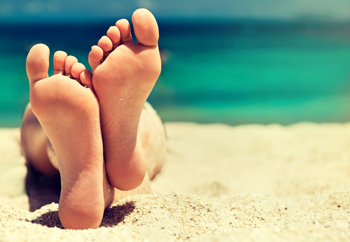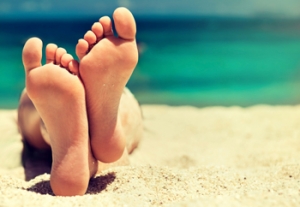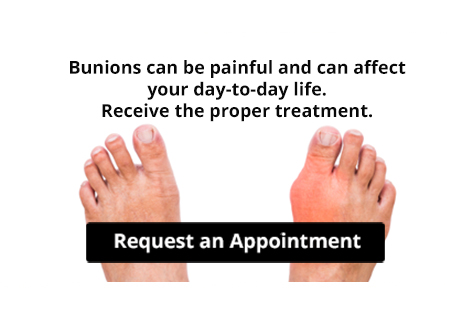Connect With Us
Super User
Various Treatments for Plantar Hyperhidrosis
 Plantar hyperhidrosis is a condition that causes excessive sweating from the feet. There are several possible treatments that your podiatrist can prescribe to reduce sweating. Treatments containing aluminum chloride, an antiperspirant, can be applied directly to the skin and are often very effective at managing excessive sweating. Topical treatments may not be suitable for those with hypersensitive skin or those with open foot wounds. Iontophoresis, a treatment that uses electrical currents to prevent excessive sweating, is safe, effective, and relatively inexpensive. Other potential treatment options include Botox injections into the feet and minimally invasive surgical procedures. These are usually suggested for patients who have not seen improvements with other treatment options. For more information about treating plantar hyperhidrosis, please consult with a podiatrist.
Plantar hyperhidrosis is a condition that causes excessive sweating from the feet. There are several possible treatments that your podiatrist can prescribe to reduce sweating. Treatments containing aluminum chloride, an antiperspirant, can be applied directly to the skin and are often very effective at managing excessive sweating. Topical treatments may not be suitable for those with hypersensitive skin or those with open foot wounds. Iontophoresis, a treatment that uses electrical currents to prevent excessive sweating, is safe, effective, and relatively inexpensive. Other potential treatment options include Botox injections into the feet and minimally invasive surgical procedures. These are usually suggested for patients who have not seen improvements with other treatment options. For more information about treating plantar hyperhidrosis, please consult with a podiatrist.
If you are suffering from hyperhidrosis contact one of our podiatrists of Podiatry Health Center. Our doctors can provide the care you need to attend to all of your foot care needs.
Hyperhidrosis of the Feet
Hyperhidrosis is a rare disorder that can cause people to have excessive sweating of their feet. This can usually occur all on its own without rigorous activity involved. People who suffer from hyperhidrosis may also experience sweaty palms.
Although it is said that sweating is a healthy process meant to cool down the body temperature and to maintain a proper internal temperature, hyperhidrosis may prove to be a huge hindrance on a person’s everyday life.
Plantar hyperhidrosis is considered to be the main form of hyperhidrosis. Secondary hyperhidrosis can refer to sweating that occurs in areas other than the feet or hands and armpits. Often this may be a sign of it being related to another medical condition such as menopause, hyperthyroidism and even Parkinson’s disease.
In order to alleviate this condition, it is important to see your doctor so that they may prescribe the necessary medications so that you can begin to live a normal life again. If this is left untreated, it is said that it will persist throughout an individual’s life.
A last resort approach would be surgery, but it is best to speak with your doctor to find out what may be the best treatment for you.
If you have any questions please feel free to contact our office located in Dothan, AL . We offer the newest diagnostic and treatment technologies for all your foot care needs.
Read more about Hyperhidrosis of the FeetHyperhidrosis of the Feet
Each foot, on average, has about 250,000 eccrine sweat glands that produce half a pint of sweat each day. Sweating is a natural and important bodily function. It regulates the body’s temperature by cooling the skin so that it does not overheat. In individuals with hyperhidrosis, the sympathetic nervous system works in "overdrive", producing far more sweat than what is required. People with plantar hyperhidrosis experience an excess amount of sweat on their feet. It is estimated that 2% to 3% of all Americans suffer from some form of hyperhidrosis. This condition is often caused by neurologic, endocrine, infectious, and other systemic disease. Other factors that may trigger the condition are heat and emotions.
People with hyperhidrosis may notice an overabundance of sweat on their feet, along with a strong odor. The feet may also have a wet appearance coupled with infections such as athlete’s foot or toenail fungus. The sweat may even appear in low temperatures, such as during the winter months. People with plantar hyperhidrosis often need to change their socks several times throughout the day.
The specific cause of hyperhidrosis is unknown, and many believe it may be caused by over-activity. However, others believe the condition is genetic. Caffeine and nicotine are known to cause excitement and nervousness which are two emotions that may make the condition worse.
If you are looking to treat your hyperhidrosis the most important thing you should do is wash your feet every day. You may even need to wash your feet twice a day, if necessary. You should also make sure you are wearing the right socks. Wool and cotton socks are both known to be good for ventilation, meaning they allow the feet to breathe. You should avoid socks made from nylon which trap moisture and lead to sogginess. Other common treatment options are over-the-counter antiperspirants that contain a low dose of metal salt. In some cases, prescription strength antiperspirants that contain aluminum chloride hexahydrate may be necessary. In severe cases, surgery may be required.
Untreated hyperhidrosis can easily lead to complications. Some complications that may arise from the disorder include nail infections, warts, and bacterial infections. Consequently, it is important that you seek treatment from your podiatrist if you suspect that you may have plantar hyperhidrosis.
Are You Suffering From Ingrown Toenails?
Foot Pain in Diabetic Patients
 Foot pain that is common among diabetic patients is often caused by elevated blood sugar levels. Intense pain and poor circulation in the feet can be a result of damaged nerve endings that is caused by high glucose levels. Patients who have diabetic foot pain can experience tingling sensations, numbness, and existing wounds may take longer to heal. Some of the foot conditions that can develop if foot pain is left untreated can include calluses, ulcers, cracked skin, and possible amputations. Methods that can be implemented which may help to avoid diabetic foot problems can consist of incorporating exercise and healthy eating habits into your daily routine, and checking your feet daily for cuts and bruises. Additionally, it can be beneficial to wear shoes while inside, as this may limit the number of wounds that can develop on the feet. If you have diabetes, it is strongly suggested that you are under the care of a podiatrist who can effectively help you to manage this condition.
Foot pain that is common among diabetic patients is often caused by elevated blood sugar levels. Intense pain and poor circulation in the feet can be a result of damaged nerve endings that is caused by high glucose levels. Patients who have diabetic foot pain can experience tingling sensations, numbness, and existing wounds may take longer to heal. Some of the foot conditions that can develop if foot pain is left untreated can include calluses, ulcers, cracked skin, and possible amputations. Methods that can be implemented which may help to avoid diabetic foot problems can consist of incorporating exercise and healthy eating habits into your daily routine, and checking your feet daily for cuts and bruises. Additionally, it can be beneficial to wear shoes while inside, as this may limit the number of wounds that can develop on the feet. If you have diabetes, it is strongly suggested that you are under the care of a podiatrist who can effectively help you to manage this condition.
Diabetic foot care is important in preventing foot ailments such as ulcers. If you are suffering from diabetes or have any other concerns about your feet, contact one of our podiatrists from Podiatry Health Center. Our doctors can provide the care you need to keep you pain-free and on your feet.
Diabetic Foot Care
Diabetes affects millions of people every year. The condition can damage blood vessels in many parts of the body, especially the feet. Because of this, taking care of your feet is essential if you have diabetes, and having a podiatrist help monitor your foot health is highly recommended.
The Importance of Caring for Your Feet
- Routinely inspect your feet for bruises or sores.
- Wear socks that fit your feet comfortably.
- Wear comfortable shoes that provide adequate support.
Patients with diabetes should have their doctor monitor their blood levels, as blood sugar levels play such a huge role in diabetic care. Monitoring these levels on a regular basis is highly advised.
It is always best to inform your healthcare professional of any concerns you may have regarding your feet, especially for diabetic patients. Early treatment and routine foot examinations are keys to maintaining proper health, especially because severe complications can arise if proper treatment is not applied.
If you have any questions please feel free to contact our office located in Dothan, AL . We offer the newest diagnostic and treatment technologies for all your foot care needs.
Read more about Diabetic Foot ConditionsDiabetic Foot Conditions
Diabetes is the condition in which the body does not properly process food for use as energy. People with Type 1 diabetes cannot produce insulin, which is required for glucose to feed your body’s cells. It is typically caused by the immune system mistaking healthy cells for foreign invaders and destroying the insulin-producing cells in the pancreas. On the other hand, people with Type 2 diabetes cannot respond to insulin properly, and eventually cannot produce enough. The Centers for Disease Control and Prevention reports that over 30 million people in the United States have diabetes, with 1 in 4 having no idea they have it. Surprisingly, diabetes is the seventh leading cause of death in the US. The symptoms of diabetes include frequent urination, fatigue, hunger, and even blurry vision.
Diabetes can also affect the feet as well. Over time, diabetes can cause nerve damage to your feet, which could then lead to symptoms such as tingling, pain and numbness in the feet. Neuropathy can be very dangerous to a person with diabetes, since it prevents them from feeling injuries such as cuts or blisters in the feet, and if not detected early enough, may lead to infection. Neuropathy can also lead changes in the shape of your feet and toes. The best way for people with diabetes to prevent or delay neuropathy is keeping their blood glucose levels in their target range. This consists of eating right, having the correct amount of exercise, and taking medications.
Diabetes can also create calluses and foot ulcers as well. Calluses build up faster and occur more frequently with those affected by diabetes. If there are too many calluses, therapeutic shoes and inserts may be required. It is important to have calluses trimmed by a health professional, as doing it yourself may lead to infections. If these calluses continue to develop and thicken, they can lead to foot ulcers. Foot ulcers are open sores, that appear on the ball of the foot or on the bottom of the big toe. These ulcers can lead to future infections if not treated and may possibly result in losing a limb. It is important to report any ulcers to your podiatrist right away. Your doctor may take x-rays to examine the foot and clean out any dead and infected tissue.
Lastly, diabetes can also lead to poor circulation and peripheral arterial disease (PAD). The poor circulation in the feet and leg area is a result of diabetes narrowing and hardening, eventually slowing down the blood flow in that area. The best way to prevent this is to keep away from smoking and follow your doctor’s advice for maintaining blood pressure and cholesterol. PAD is similar to this complication. PAD is when blood vessels narrow or are blocked by fatty deposits. PAD also increases your risk of heart attacks and strokes and is a common condition to those affected by diabetes. The combination of both PAD and neuropathy may lead to infections and can result in amputation of certain limbs. PAD can be prevented with wearing the proper foot wear and regularly taking care of your feet.
If you want to take care of your feet, you should wash and dry them carefully and perform daily inspections to check for cuts, blisters, or swelling. Any physical activity you partake in should be approved by your health care provider. You should also be sure to wear special shoes if advised to do so by your doctor.
When Nerve Damage Disrupts Messages Between the Brain and Feet
 The peripheral nervous system transmits signals between the central nervous system (brain and spinal cord) and organs and limbs. For example, peripheral nerves would send a signal to the central nervous system regarding pain in the foot and the brain would direct the body to respond accordingly—that is, when this messaging system works correctly. In peripheral neuropathy there is damage to the peripheral nerves, which impedes this messaging system. Peripheral neuropathy is commonly caused by diabetes, but may also be present due to heredity, side effects of chemotherapy, drug or alcohol abuse, and other illnesses. Peripheral neuropathy can trigger symptoms in the feet such as numbness or an inability to perceive pain or temperature, cramping, muscle weakness, or tingling. Diabetic neuropathy can be particularly problematic as even minor cuts or abrasions can go undetected and turn into wounds or ulcers. If you are experiencing any of the symptoms listed, contact a podiatrist for a full examination and evaluation to determine if you may have peripheral neuropathy.
The peripheral nervous system transmits signals between the central nervous system (brain and spinal cord) and organs and limbs. For example, peripheral nerves would send a signal to the central nervous system regarding pain in the foot and the brain would direct the body to respond accordingly—that is, when this messaging system works correctly. In peripheral neuropathy there is damage to the peripheral nerves, which impedes this messaging system. Peripheral neuropathy is commonly caused by diabetes, but may also be present due to heredity, side effects of chemotherapy, drug or alcohol abuse, and other illnesses. Peripheral neuropathy can trigger symptoms in the feet such as numbness or an inability to perceive pain or temperature, cramping, muscle weakness, or tingling. Diabetic neuropathy can be particularly problematic as even minor cuts or abrasions can go undetected and turn into wounds or ulcers. If you are experiencing any of the symptoms listed, contact a podiatrist for a full examination and evaluation to determine if you may have peripheral neuropathy.
Peripheral artery disease can pose a serious risk to your health. It can increase the risk of stroke and heart attack. If you have symptoms of peripheral artery disease, consult with one of our podiatrists from Podiatry Health Center. Our doctors will assess your condition and provide you with quality foot treatment.
Peripheral artery disease (PAD) is when arteries are constricted due to plaque (fatty deposits) build-up. This results in less blood flow to the legs and other extremities. The main cause of PAD is atherosclerosis, in which plaque builds up in the arteries.
Symptoms
Symptoms of PAD include:
- Claudication (leg pain from walking)
- Numbness in legs
- Decrease in growth of leg hair and toenails
- Paleness of the skin
- Erectile dysfunction
- Sores and wounds on legs and feet that won’t heal
- Coldness in one leg
It is important to note that a majority of individuals never show any symptoms of PAD.
Diagnosis
While PAD occurs in the legs and arteries, Podiatrists can diagnose PAD. Podiatrists utilize a test called an ankle-brachial index (ABI). An ABI test compares blood pressure in your arm to you ankle to see if any abnormality occurs. Ultrasound and imaging devices may also be used.
Treatment
Fortunately, lifestyle changes such as maintaining a healthy diet, exercising, managing cholesterol and blood sugar levels, and quitting smoking, can all treat PAD. Medications that prevent clots from occurring can be prescribed. Finally, in some cases, surgery may be recommended.
If you have any questions, please feel free to contact our office located in Dothan, AL . We offer the newest diagnostic and treatment technologies for all your foot care needs.
Read more about Peripheral Artery DiseasePeripheral Artery Disease
Peripheral artery disease (PAD), or peripheral arterial disease, is a circulatory problem in which there is a reduction of blood flow to the limbs due to narrowed arteries. When peripheral artery disease develops, the extremities do not receive enough blood flow; this may cause symptoms to develop such as claudication, or leg pain when walking. The legs are the most common site of peripheral artery disease.
Claudication, or leg pain when walking, is one of several symptoms that can develop due to peripheral artery disease. Other symptoms caused by the disease include painful cramping in the hips, thighs, or calves after certain activities; leg numbness or weakness; coldness in the lower leg or foot; sores on the lower extremities that do not heal; hair loss on the lower extremities; and a missing or weak pulse in the lower extremities. In more severe cases, pain may even occur when the body is at rest or when lying down.
Peripheral artery disease is typically caused by atherosclerosis, a condition in which fatty deposits build up in the arterial walls and reduce blood flow. Smoking, diabetes, obesity, high blood pressure, and high cholesterol are some of the risk factors for peripheral artery disease.
If you are experiencing pain, numbness, or other symptoms in the lower extremities, see your healthcare professional immediately. Diagnosed peripheral artery disease can be treated with various medications, angioplasty and surgery, exercise programs, or alternative medicine. It is important to consult a healthcare professional to determine the best treatment for you.
Are Bunions Affecting Your Everyday Life?
Solutions for Cracked Heels
Cracked heels may make you want to think twice about showing off your feet in warmer weather. However, cracked heels may be harmful to more than just the appearance of your feet. If deep fissures and cracks develop in your heels, they may make walking and standing painful for you. Additionally, these openings make way for germs to enter through your skin and cause infection.
There are several different causes of cracked heels. One of the most common reasons for this ailment is dry skin. This problem may make your keeps feel rough tight and itchy. Dry skin may be caused by cold air, extremely hot water, harsh soaps, and aging. Skin disorders such as eczema and psoriasis may eventually lead to dry skin. In some cases, complications may arise from cracked heels. Some of these complications are a loss of feeling in the heel, cellulitis, or a diabetic foot ulcer.
There are ways you can try to prevent getting cracked heels. One of the best ways to do so is to avoid wearing flip flops and sandals because these shoes increase your risk of drying out your feet. You should also avoid wearing shoes with a tall skinny heel, because these shoes cause your heel to expand sideways. At night, you should slather on a thick moisturizing cream on your feet and then cover them in socks to keep your feet moisturized overnight. Drinking water to stay hydrated is also a good way to ensure that your skin doesn’t become dry.
If you suffer from a severe case of cracked feet, you should make an appointment with your podiatrist to see what treatment methods are best for you.
How Are Feet Affected by Pregnancy?
The excessive weight gain and hormonal surges women experience during pregnancy can cause swollen feet and ankles, pain in the heel, arch, and balls of the feet, as well as cramping, and varicose veins in the legs. Pregnant women can also be more prone to rolling their feet inwardly while walking (over-pronating), and their feet usually lengthen and flatten out. Their balance can also be affected throughout pregnancy. If you are pregnant and notice any of these symptoms within your feet, consulting with a podiatrist is suggested. A podiatrist can help ease these symptoms during pregnancy with practical tips, foot exercises, shoe recommendations, as well as custom orthotics to disburse weight more evenly across the foot, relieve pressure points, and correct alignment.
Pregnant women with swollen feet can be treated with a variety of different methods that are readily available. For more information about other cures for swollen feet during pregnancy, consult with one of our podiatrists from Podiatry Health Center. Our doctors will attend to all of your foot care needs.
What Foot Problems Can Arise During Pregnancy?
One problem that can occur is overpronation, which occurs when the arch of the foot flattens and tends to roll inward. This can cause pain and discomfort in your heels while you’re walking or even just standing up, trying to support your baby.
Another problem is edema, or swelling in the extremities. This often affects the feet during pregnancy but tends to occur in the later stages.
How Can I Keep My Feet Healthy During Pregnancy?
- Wearing orthotics can provide extra support for the feet and help distribute weight evenly
- Minimize the amount of time spent walking barefoot
- Wear shoes with good arch support
- Wear shoes that allow for good circulation to the feet
- Elevate feet if you experience swelling
- Massage your feet
- Get regular, light exercise, such as walking, to promote blood circulation to the feet
If you have any questions please feel free to contact our office located in Dothan, AL . We offer the newest diagnostic and treatment technologies for all your foot care needs.
Read more about Pregnancy and Foot Health








